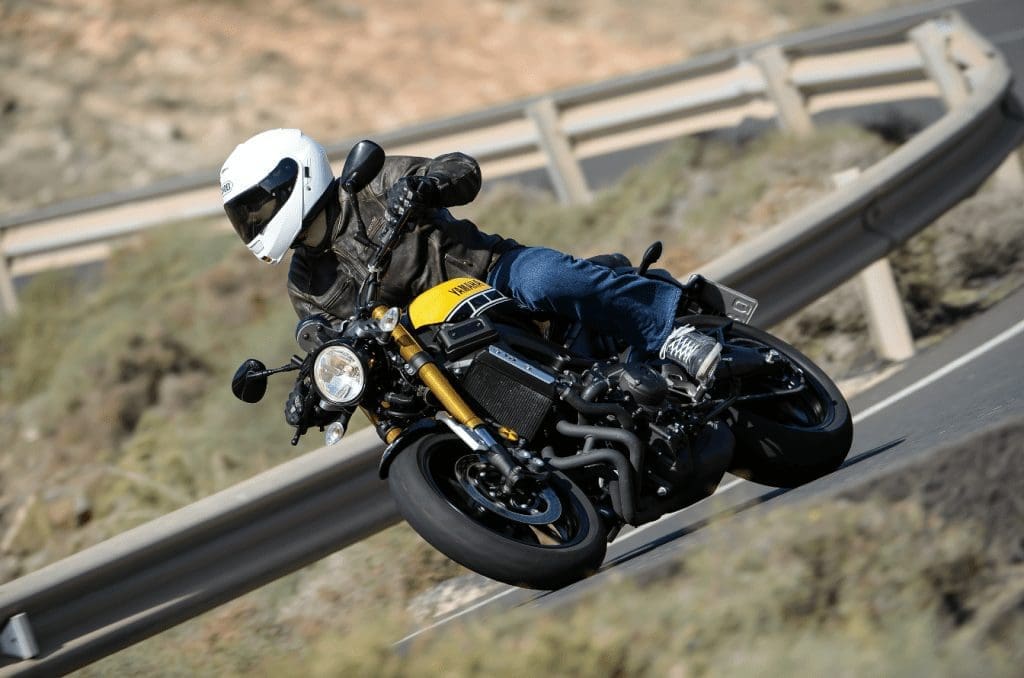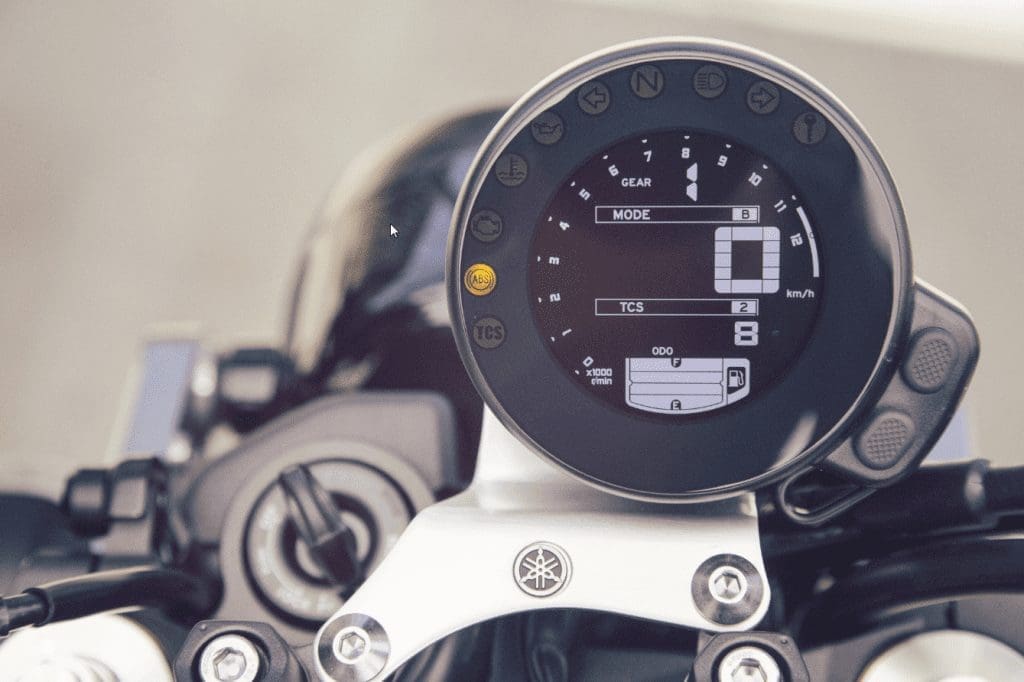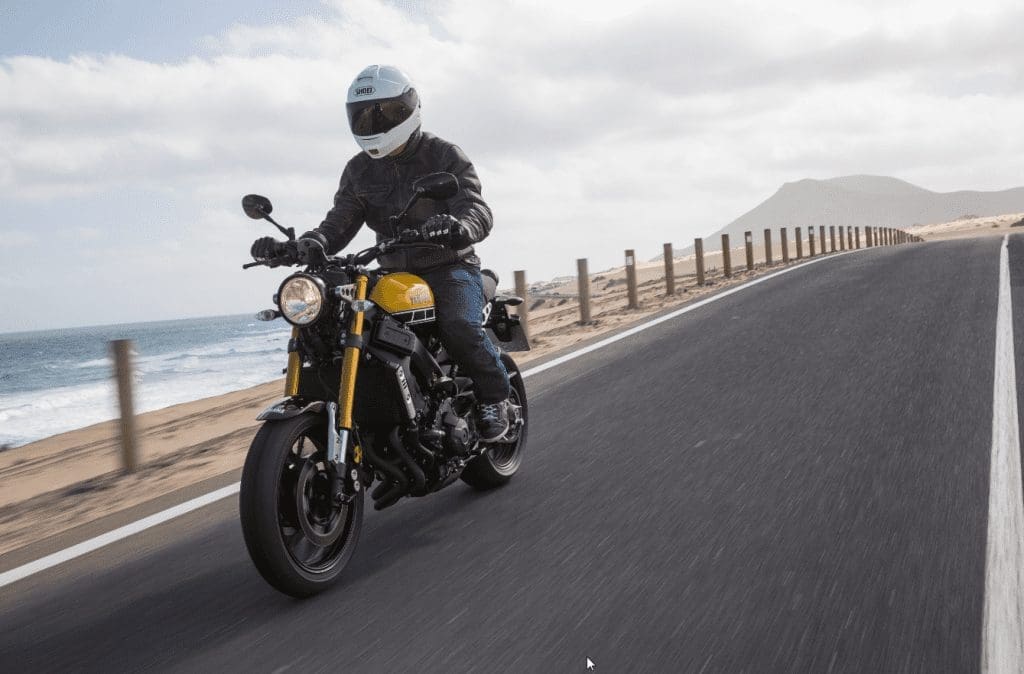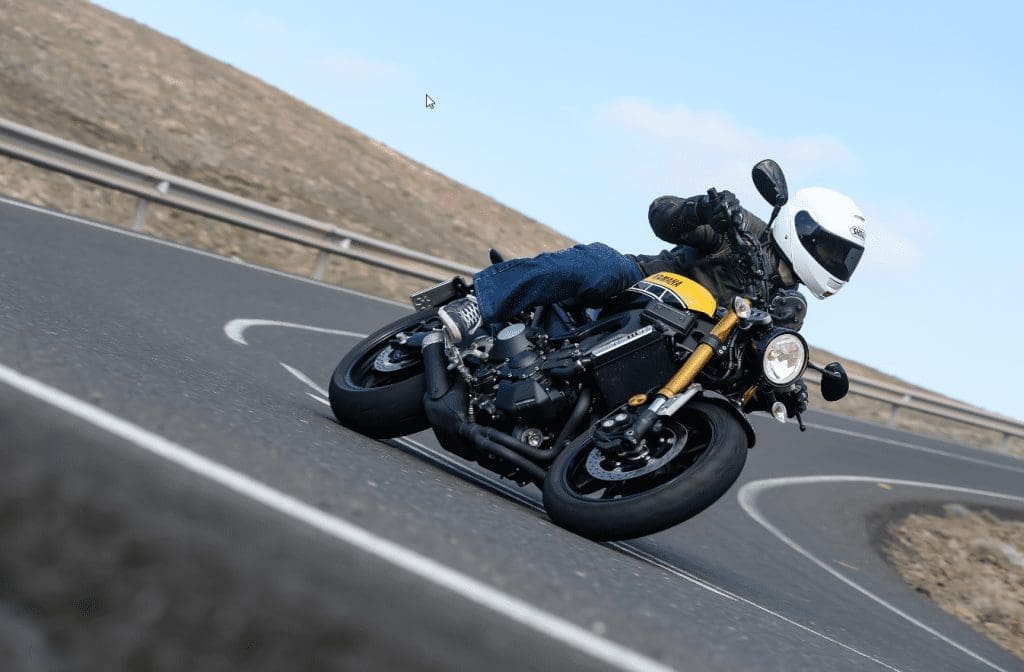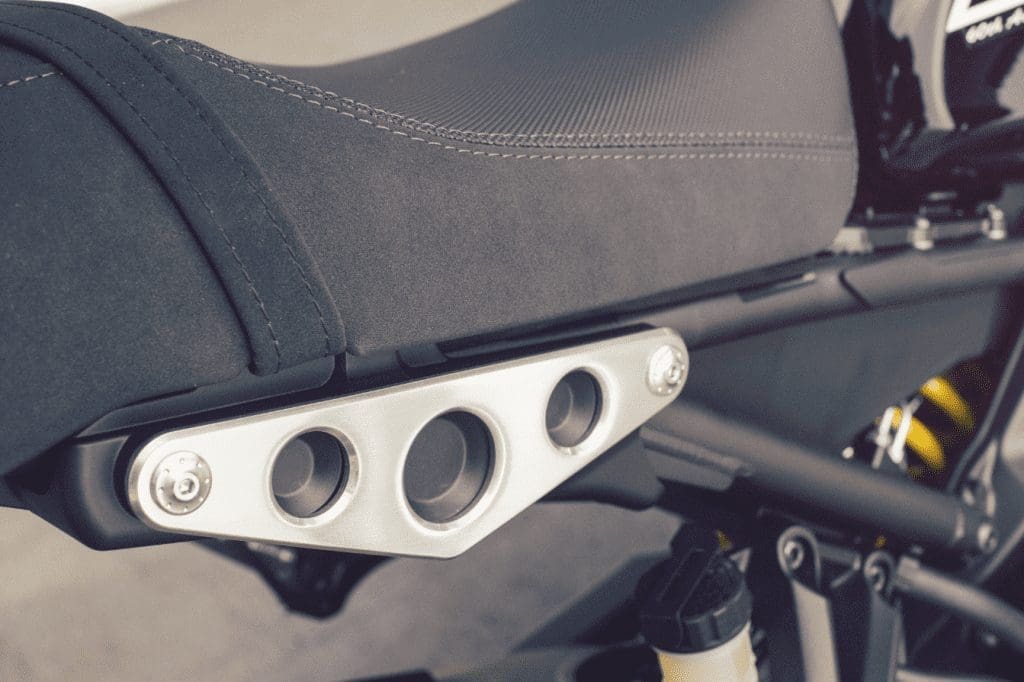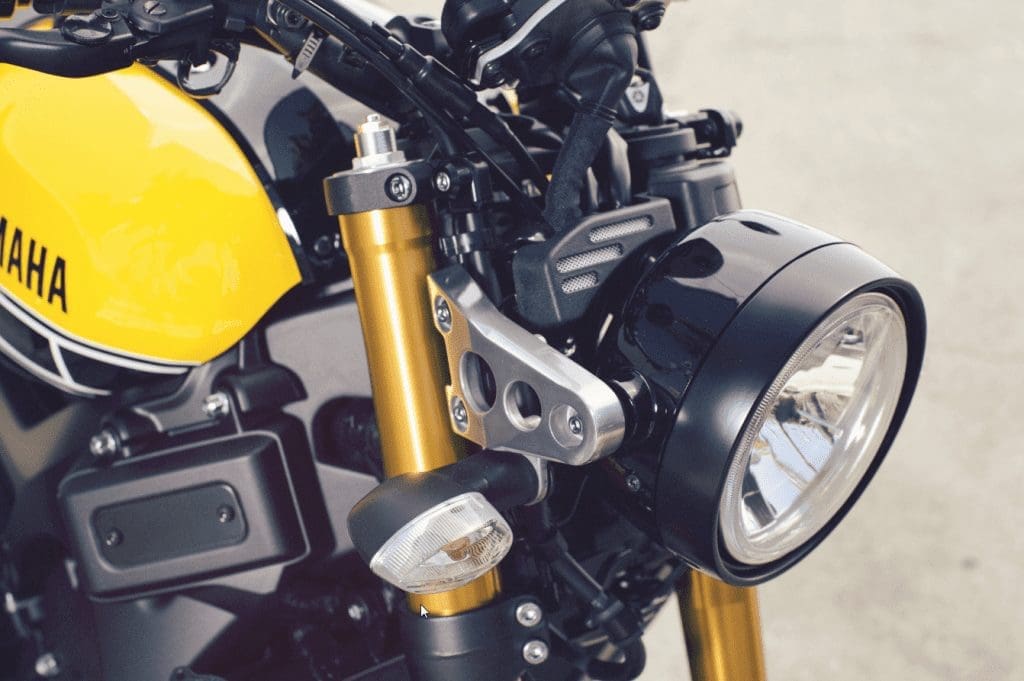For Mikko’s video review of the Yamaha XSR900, click here.
Price: Matt grey and rock slate £7,849 / 60th Anniversary colour scheme £ 7,999
Engine: 847cc, three-cylinder, liquid-cooled, four-stroke, DOHC, four-valve
Power: 113bhp at 10,000rpm
Torque: 87.5Nm at 8,500rpm
Tested by: Mikko Nieminen
Whether you’re a fan or not, there’s no escaping the fact that the retro bike scene is booming. BMW is adding vintage flavour to its range with the introduction of the RnineT Scrambler, while Ducati is creating a whole brand around what it calls the ‘land of fun’. Closer to home, Triumph’s new Bonneville range boasts some of the best looking bikes to roll out of the Hinckley factory in quite some time.
Yamaha’s answer to the trend is its Sport Heritage line-up, inspired by the Faster Sons philosophy of combining timeless style with cutting-edge technology. The latest addition to the range is the XSR900. Engineered with sporty performance, at home on the retro scene and offering plenty of scope for customisation, this could be the bike that outsells Yamaha’s golden goose, the naked MT-09.
The two machines share the same triple engine and chassis. But make no mistake, this is not just a dressed up hooligan. Parts might be shared, but fuelling, suspension settings and looks have all been revised.
First impressions count
What stands out from the start is that the XSR900 has been carefully designed to appeal as a lifestyle choice as much as a bike. It’s full of clever and visually pleasing details. Some of them provide a function, such as the beautifully crafted tank cover bolts. Others, like the perforated aluminium plates below the seat, have been added purely for aesthetic purposes.
Perched safely on the lofty seat, it takes no time at all to familiarise yourself with the dash and switchgear. The bike starts with a little pull of the spring-loaded red button that doubles up as the engine kill switch. Everything else is exactly where you’d expect (I only sounded the horn once when trying to cancel the indicator, which is something of a personal record). In addition to the ignition, indicators, horn and lights, you control the ride modes and traction control with two buttons in the switchgear.
The classic round shape and the modern digital face of the single dash fit the retro looks perfectly. What’s more, the dash is easy to read – even in bright sunshine – and gives you all the info you need – from speed, revs, gears and fuel to traction control, ride modes, temperature and trips.
The bike is 4kg heavier than its organ donor, the MT-09, but weighing in at 195kg (wet) and with its narrow frame, it’s still not porky by any means. Crawling out of the car park, the first impression was that the bike was very easy to manoeuvre at slow speeds. With a touch of the rear brake it felt stable and fully under control.
Triple the fun
With the aim of appealing to riders across the board, the XSR900 features three ride modes: Standard, A and B. Mode A offers a more aggressive power delivery option and mode B a smoother ride. The standard mode provides a neutral middle ground. I found both the A and standard settings a bit too perky for my riding style, but if you want to make the bike respond instantly to the slightest touch, the option is there. I prefer a slightly smoother throttle response and spent most of the day in B-mode, which still lets you have plenty of fast fun but adds an element of calm to the journey. It’s not unlike the feeling that you get from riding a carburettor-fuelled bike.
Regardless of the chosen ride mode, the XSR900 is a powerful and torquey machine. The 847cc liquid-cooled three-cylinder engine is the same CP3 Crossplane Concept engine that features on the MT-09. The claimed power output is 113bhp at 10,000rpm, with a torque figure of 87.5Nm at 8,500rpm.
The bike accelerates effortlessly from low in the rev range all the way to the redline at 11,000rpm where the limiter kicks in. We rode the bikes on the mountain roads of Fuerteventura, full of flowing second and third gear bends, where the powerful triple engine really performed to its full potential. Because there’s enough grunt throughout the rev range, shifting up and down was minimal and powering out of corners was both fun and easy.
The slipper clutch is very light to operate (20% lighter than the one on the MT-09, according to Yamaha) and the gearbox is accurate, making shifting up and down smooth and effortless.
Keeping the shiny side up
With great acceleration comes great demand for traction control. The XSR900 offers a three-level solution: you can switch the traction control off or choose between levels 1 (less intrusive) and 2 (more intrusive). I started the day on level 2, but felt that it was kicking in too early during hard acceleration, which I found a little unsettling. Once I switched to level 1, I was much happier as I could still fly out of corners fast, safe in the knowledge that if I got too carried away the system would come to my rescue. I would probably only use the level 2 setting on wet and greasy roads for additional peace of mind.
The XSR900 may have inherited its 41mm upside down forks and the linked-type monocross shock system from the MT-09, but the settings have been revised to make the suspension more firm. Rebound damping is adjustable at the front, and both preload and rebound damping at the rear, but I was quite happy with the performance using the standard settings and did not tamper with them at all.
The roads in Fuerteventura are among the smoothest that I have ever ridden on, so the suspension didn’t get quite the abuse that it might do back in the UK, but the few bumps in the roads that we encountered on the 150-mile ride it handled to the extent that I didn’t even feel the need to change the settings. In corners, both fast and faster, the bike feels very stable and firmly planted. Slight adjustments to the cornering line don’t upset the bike or cause wobbles, and it’s easy to feel confident on the bike.
The brakes are standard spec (no Brembos here) but they work perfectly well, and aside from testing their bite, I only ever had two fingers on the front brake lever, which was enough to shave off a bit of speed for the tighter corners. ABS comes as standard, but there’s no option to switch it off, so if you want to be able to lock the brakes you have to pull the fuse out.
Faster Sons like comfort too
The wide bars and the comfy seat put the rider in control. Steering is stable and accurate and the riding position is very natural. The handlebar and foot peg positions are the same as on the MT-09, but the tank is slightly longer on this bike, which pushes the seat further back. Overall, the riding position is very pleasant. It was only after we had finished the ride that I realised I had not felt the need to stretch my legs once during the day’s riding, which is quite unusual.
The only ergonomic problem is caused by a little exhaust guard just behind the right foot peg, which stops your heel dangling free. It’s not a massive issue, but having your ankles at different angles feels a little strange at first. Still, it’s a good looking exhaust, and for that you can forgive a slight ergonomic compromise.
Same, same, but different
Customisation is an integral part of the retro scene and Yamaha has not missed a trick here. Not only did the company team up with custom bike builder and ex-racer Roland Sands to produce the one-off ‘Faster Wasp’ to breathe some sporting heritage and custom cool into the XSR900 project, but it has also produced a bike that’s easy to customise in your own garage.
The sub-frame can be removed by simply unscrewing a few bolts, opening doors to easy modification. The actual tank is hiding under two aluminium covers, which can also be easily removed, painted or replaced.
Yamaha has also put together a collection of factory accessories. And if that’s not enough, there will also be aftermarket goodness from Roland Sands Design and others.
Should I buy one?
It’s difficult to pick fault with this bike. The engine is powerful, the chassis is solid if quite basic, and the overall riding experience is very positive. And then there’s the price: available from mid-March, the blue and grey (or rock slate and matt grey, to use Yamaha’s terms) models cost £7,849 and the 60th Anniversary special (the yellow, black and white ‘bumblebee’ colour scheme) is £7,999. That’s well below the prices of the Triumph Speed Triple S (£10,200) and the BMW RnineT (£11,900), so it might make sense to consider this slightly smaller machine and save enough money to customise the living daylights out of it. If I had a bit of cash stashed away, that’s what I’d do.
Specification
Engine
| Engine type | 3-cylinder, liquid-cooled, 4-stroke, DOHC, 4-valve |
| Displacement | 847 cm³ |
| Bore x stroke | 78.0 mm x 59.1 mm |
| Compression ratio | 11.5 : 1 |
| Maximum power | 84.6 kW (115PS) @ 10,000 rpm |
| Maximum torque | 87.5 Nm (8.9 kg-m) @ 8,500 rpm |
| Lubrication system | Wet sump |
| Clutch type | Wet, Multiple Disc |
| Fuel system | Fuel Injection |
| Ignition system | TCI |
| Starter system | Electric |
| Transmission system | Constant Mesh, 6-speed |
| Final transmission | Chain |
Chassis
| Frame | Diamond |
| Front suspension system | Telescopic forks |
| Front travel | 137 mm |
| Caster angle | 25º |
| Trail | 103 mm |
| Rear suspension system | Swingarm (link-type suspension) |
| Rear travel | 130 mm |
| Front brake | Hydraulic dual disc, Ø 298 mm |
| Rear brake | Hydraulic single disc, Ø 245 mm |
| Front tyre | 120/70ZR17M/C (58W) (Tubeless) |
| Rear tyre | 180/55ZR17M/C (73W) (Tubeless) |
Dimensions
| Overall length | 2,075 mm |
| Overall width | 815 mm |
| Overall height | 1,135 mm |
| Seat height | 830 mm |
| Wheel base | 1,440 mm |
| Minimum ground clearance | 135 mm |
| Wet weight (including full oil and fuel tank) | 195 kg |
| Fuel tank capacity | 14 L |
| Oil tank capacity | 3.4 L |

